| |
|||
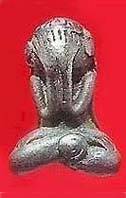 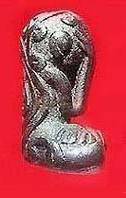 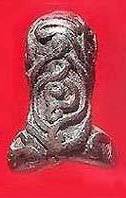 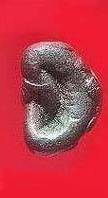 |
|||
|
|||
Phrakawam Bodi |
|||
| The figure of SANGAJAYANA , the monk of great fortune who lived in the Lord
Buddha time or around 2,500 years ago , has been made in other two transformed forms. The
first one is Phra Kawampati(Pali pronunciation) or Phra Kawambodi(Thai
pronuciation), which means the monk who was not looked like Lord Buddha.
After Sangajayana had magically transfromed his body, he was also
called Kawampati. The word "Kawam" means Lord Buddha while "Pati"
is a denial suffix . And the other form of Sangajayana
is Phra Pit Thawan.
Both figures have popularly been made by
magic-expert monks in small size as hanging amulets. |
|||
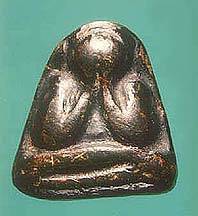 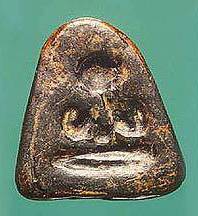 |
An old Phra Kawambodi or Phra Pitta
Wat Krua Walya, made from holy-powder plaster mixed with black lacquer. |
||
Practically,Thai amulet users call Phra Kawambodi with the plain word as "Phra Pitta" which means the monk lifting his hands covering his eyes. Phra Kawambodis made of and from various materials aim at 3 main purposes:- The first for self attractiveness and fortune, the amulets are made from white holy-powder plaster.The second for self protection and also for fortune effects, the amulets are made from holy-powder plaster mixed with black lacquer. The third for impenetrability or invulnerability, the amulets are made of various metals. In the past, other materials such as ivory tusk or even wood were also used to make amulets. Phra Kawambodi figure is easy to remember, he has a round-naked head with or without big potbelly, but his both hands are lifting up to cover his eyes. |
|||
An old silver-based Phra
Pitta Maha Ut, Wat Thong Temple. |
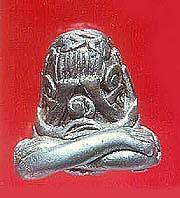 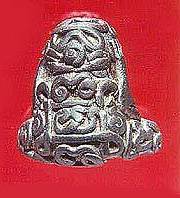 |
||
For the Phra Pit Thawan, it has more magnificent form. Normally,Phra Pit Thawan has his hands more than two, it is frequenly made 3-4 pairs of hands.The first pair covers his both eyes.The second pair covers his both ears while the third pair moves downward and bends to cover his anus.And there may be the fourth pair to cover the navel. What does it mean by this posture? The answer is that the primary gate of all sufferings of human is our own sensory perception organs,i.e.eyes,ears,nose,tongue,trunk and mind. Phra Pit Thawan (Thai vocabs: Phra=monk figure; Pit=to close,to cover; Thawan=vents, outlets) is hinting on controlling those organs by covering them to prevent all sufferings to enter. Is that like the ostrich putting its long head into a sand hole to perceive nothing all around? No, it's absolutely not like that. He is hinting a profound meaning of advanced Dhamma (Buddha's teachings). That is seeing is just seeing, touching is just touching, and knowing is just knowing. You realize all things happening with full consciousness but neutralized mind. The good quality mind of this state will develop the inner body higher. You are not sensitive to all things shaking around, you have no extreme feelings of both great sorrow and delightfulness. But the most important thing is that you have peacefulness in your mind, and you can strongly stand up to every kind of sufferings. Many people practiced this great way and the miracle of mind automatically occured, they have ESP, precognition, capability of out-of-body, and healing powers. But the most important thing is that one can use this clean mind to focus on Dhamma to reach the state of Niravan or Nibbhan, i.e.the self enlightenment. |
|||
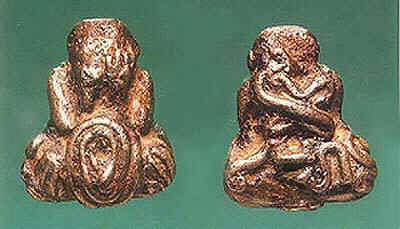 |
An old Iron-based Phra Pitta Maha Ut(Rae Bang Phai),Wat Moli Temple. | ||
The posture of Phra Pit Thawan teaches us to be alert on our own sensory perception organs by not allowing them go freely but mastering them instead. The alert and full realization on all sensory perception organs is called by Thai Buddhists " Inciya Sangworn" The Inciya Sangworn posture of both Phra Kawambodi and Phra Pit Thawan hint
the same Dhamma meaning. But the Thai magic gurus of "Saiya
Vej" preferably interpreted the posture of Phra Pit Thawan the good omen
for "Kong Kra Phan Chatri", the
impenetrability or invulnerability. Why ? Because they believed that Phra Pit Thawan
closes all its "windows", all
sufferings and all kinds of dangers cannot enter or even come closer. Thai people
call this "Klaew Klad", the state |
|||
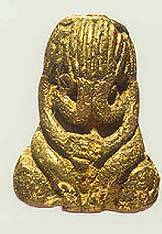 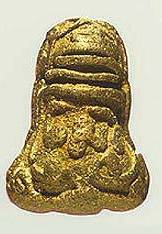 |
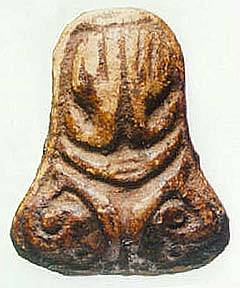 |
||
| Phra Pitta Maha Ut, Wat Nhang Temple. LEFT: An old silver-based made piece. RIGHT: An old holy-powder made piece. | |||
"Phra Pit Thawan" is the old name, but it's now popularly called "PHRA PITTA MAHA UT" which means the monk of great impenetrability with his hands covering both eyes. But practically,Thai amulet users also shortly call Phra Pitta Maha Ut as " Phra Pitta", just the same as Phra Kawambodi. It is not confused by their same short names because the old Phra Pittas of each temple have their own specific forms . In among Thai amulet collectors, the word "Phra Pitta" followed by the name of the temple of origin is clear enough to identify which Phra Pitta they meant for. Phra pitta Maha Uts have also popularly been made in small amulet forms from silver-based alloy, iron-based alloy and bronze-based alloy, etc. Making Phra Pitta Maha Uts have more complicated religious ritual than Phra Kawambodis. And with their superb designs, Phra Pitta Maha Uts always bear the ancient magic script for impenetrability or invulnerability purpose. Such the scripts are as follows: The Earth's Four Essential Elements
"Na-Ma-Pa-Tha" (earth,water,wind and fire), The Name of the Five Buddhas
(Na-Mo-Bhut-Tha-Ya),The Essence of the Three Diamonds (A-Oo-Ma), or even a single
universal magic character of " Na" or "Oo", etc. |
|||
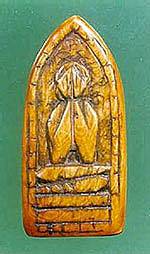 |
 |
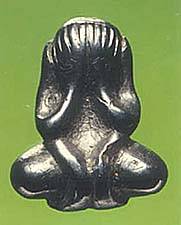 |
|
|
|||
Some old Phra Pitta Maha Uts are very expensive, it can cost more than US $20,000 per piece in Thailand with its weight not over 50 gms .Yes, it's the world most expensive ordinary metal piece! Remember that all Thai amulets of every piece and every kind must have been blessed, with no exception, through the consecration rituals performed by the meditative guru monks, otherwise they are faked or ineffective amulets for wearing. It's just like you pick up a piece of rock or metal on the street and then wear it on your neck! |
|||
| index : Thailand's Great Guru Monks HOME | SANGAJAYANA | SIVALI | NANGKWAK | RAJASIHA | KHUN PAEN | CHINNARAJ INDOCHINE B.E.2485 | | LUANG PHOR PARN | LUANG PHOR CHONG | |
|||
| Thai Amulets by "Lek Watruak" Copyright © 1999-2009 LEK WATRUAK. All Rights Reserved. |
|||